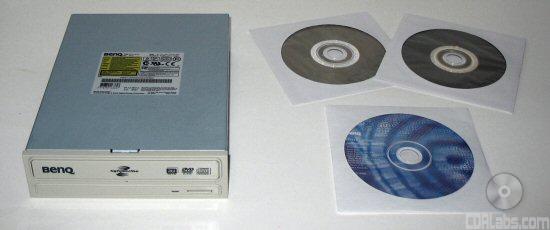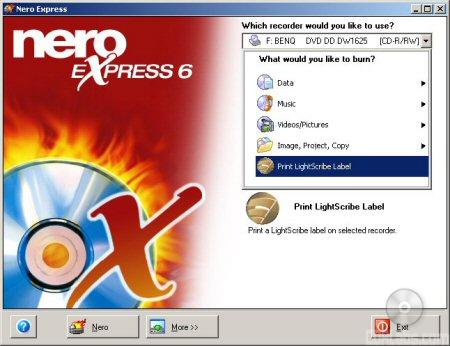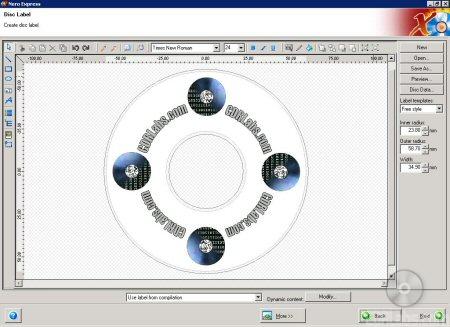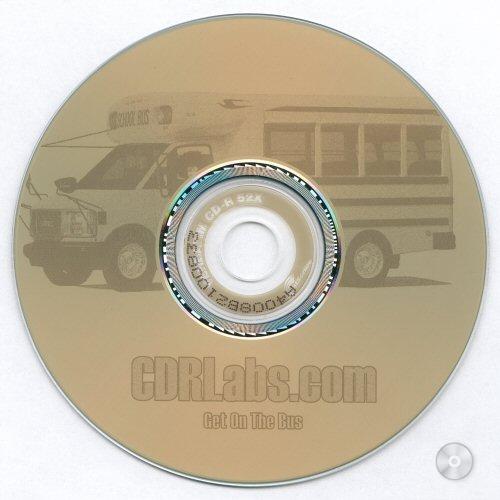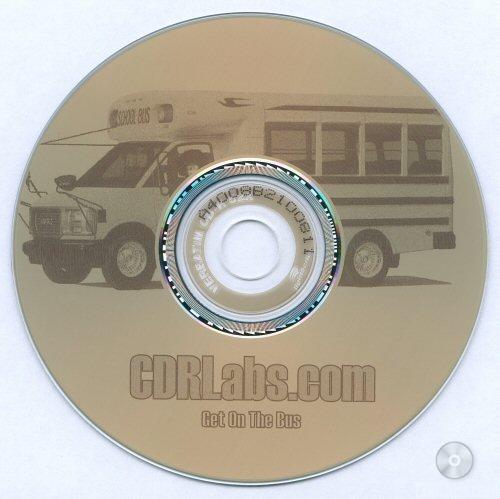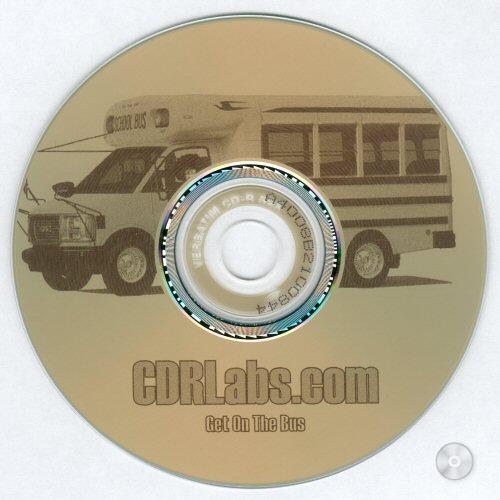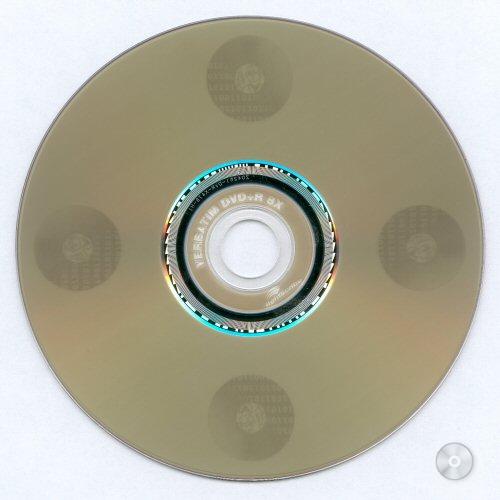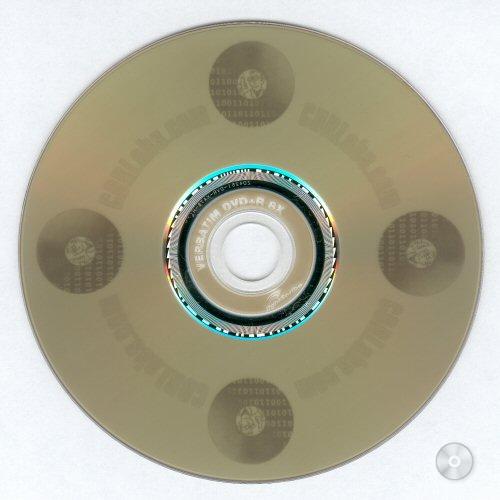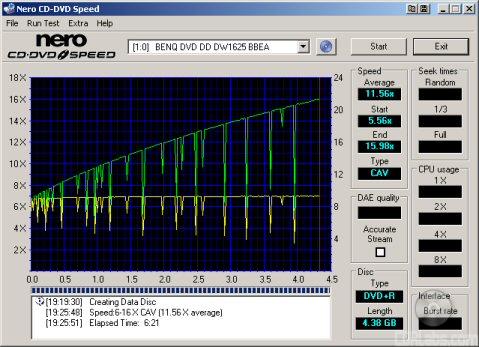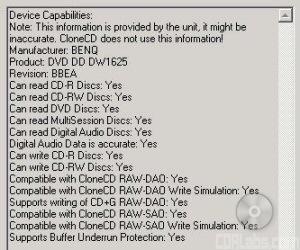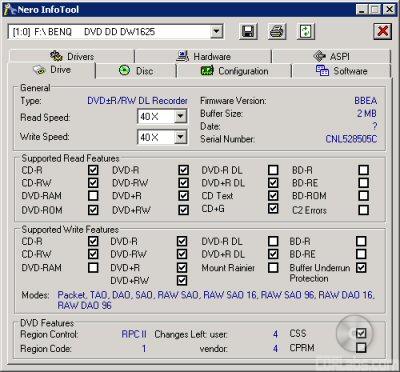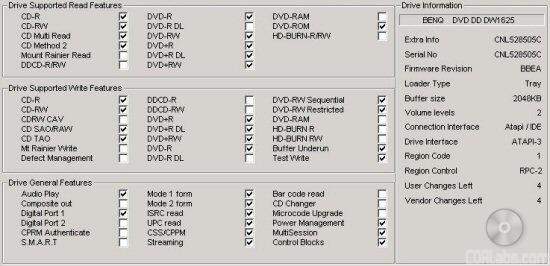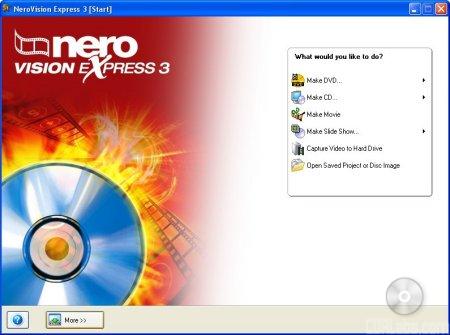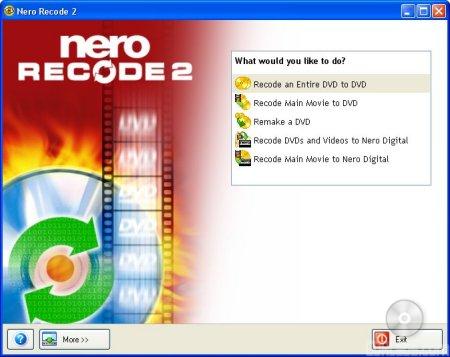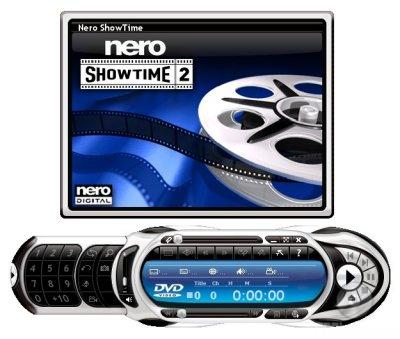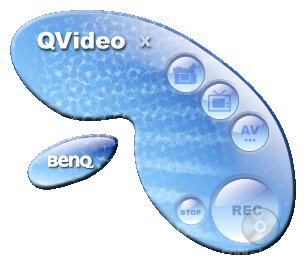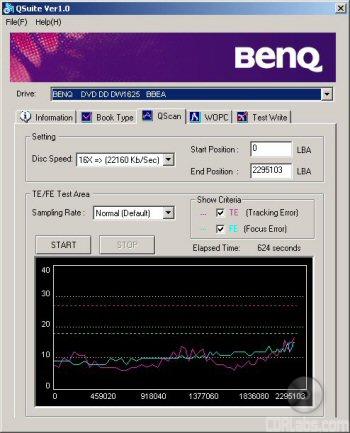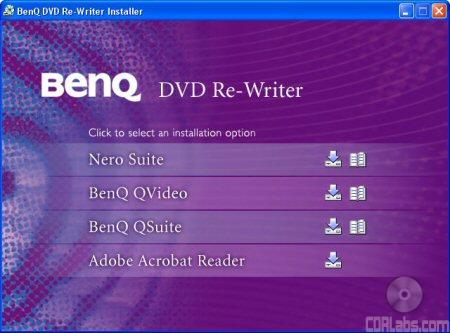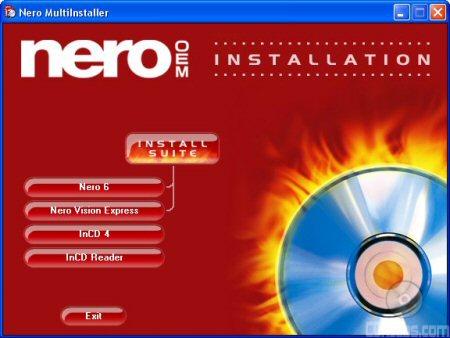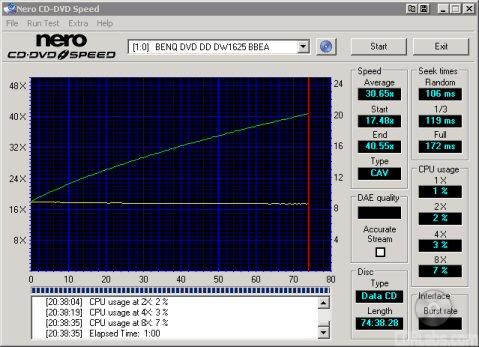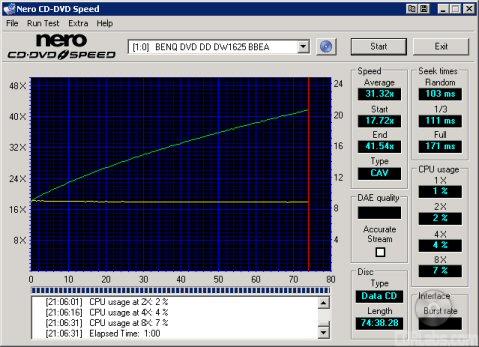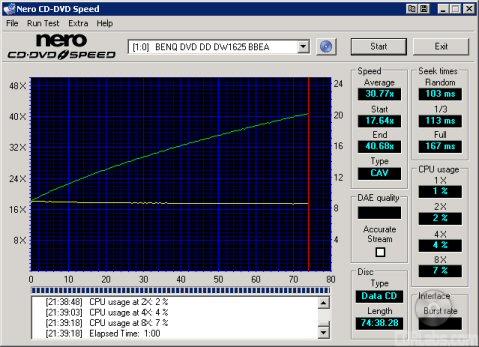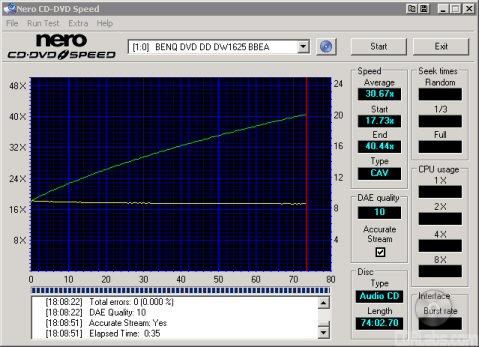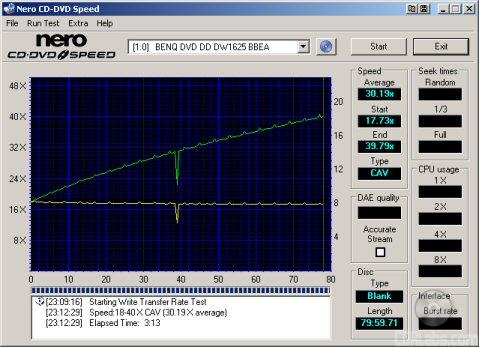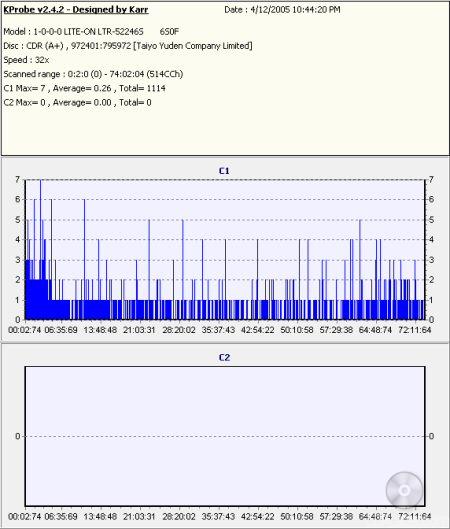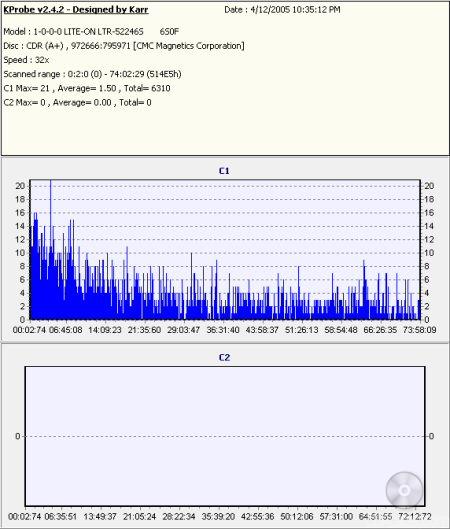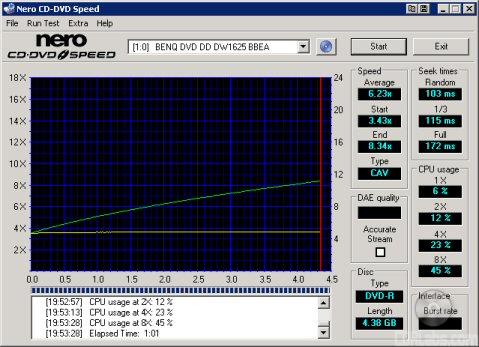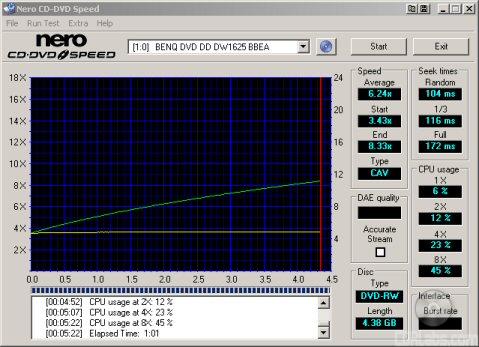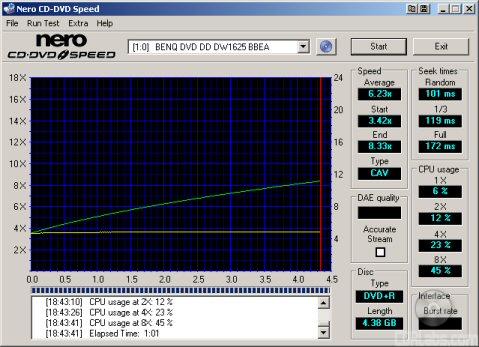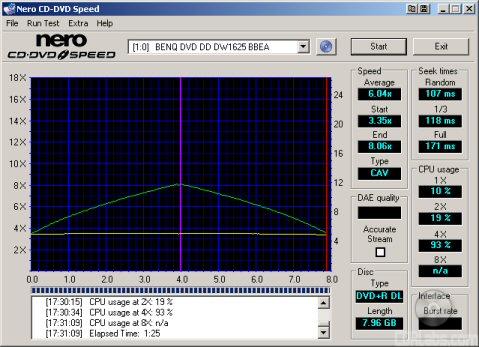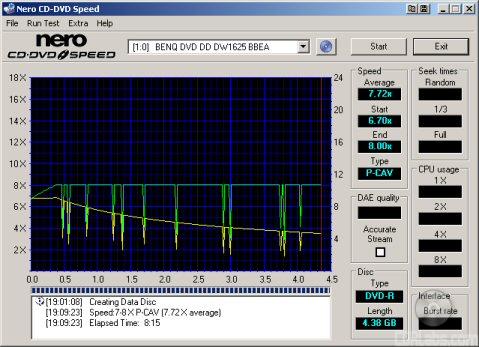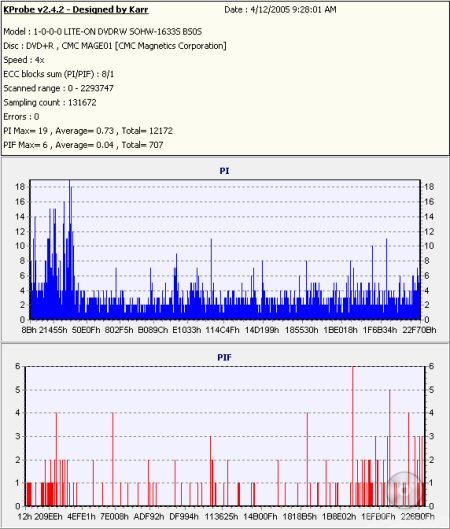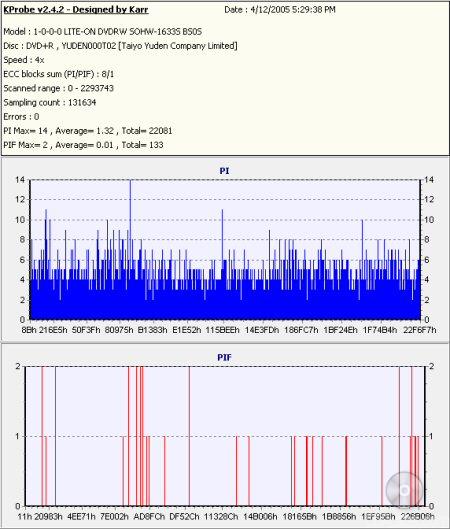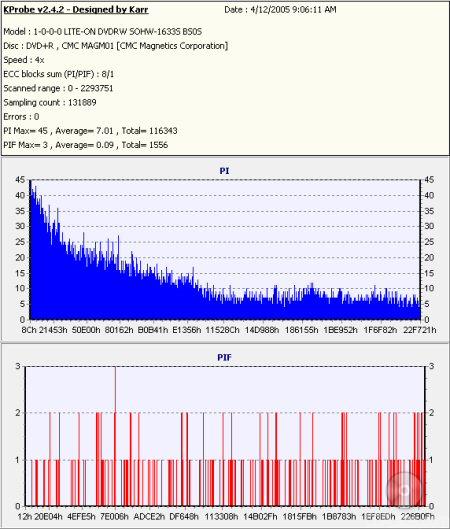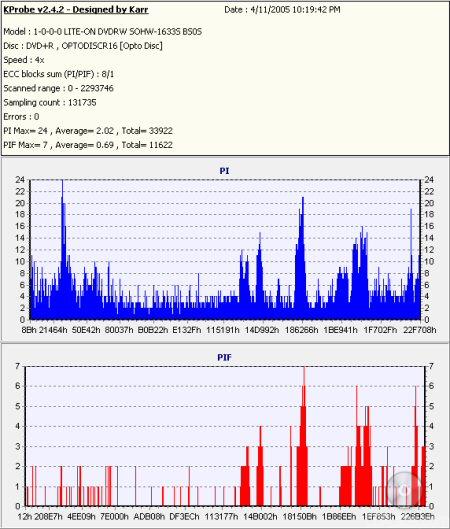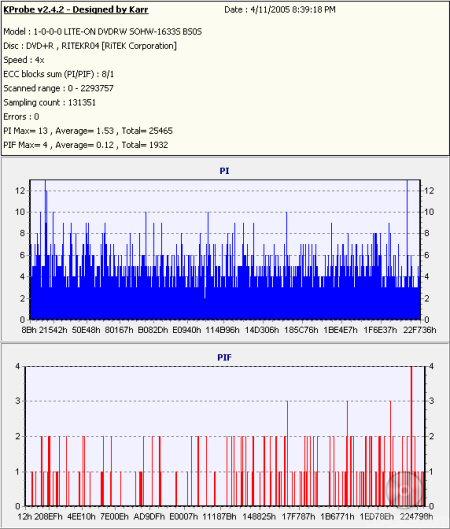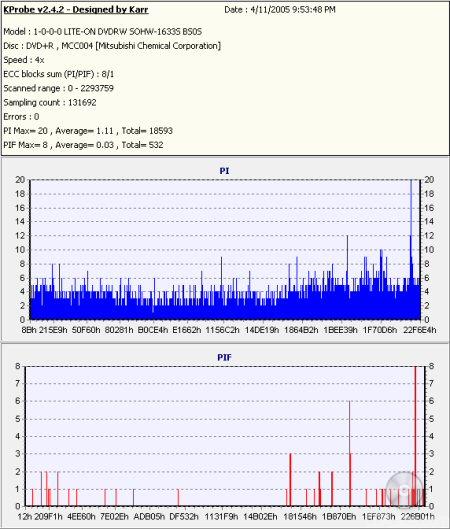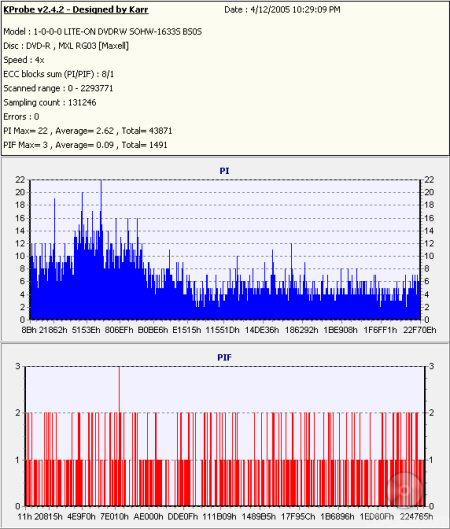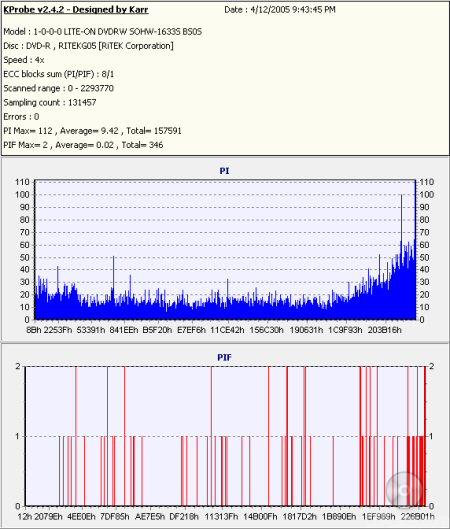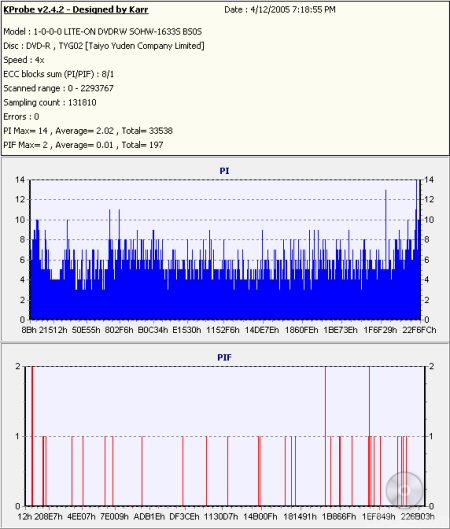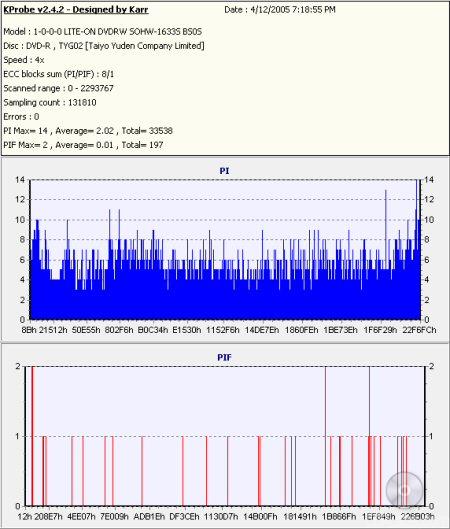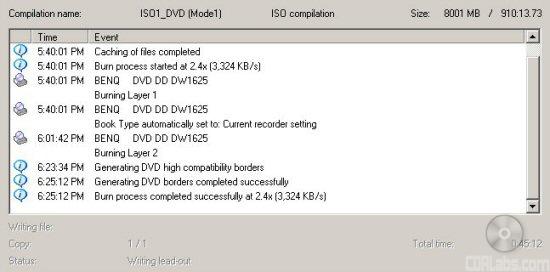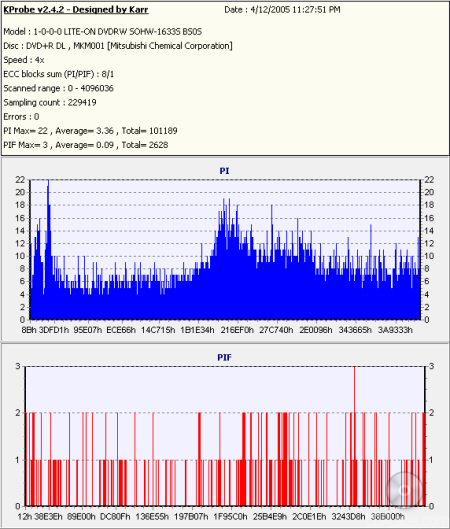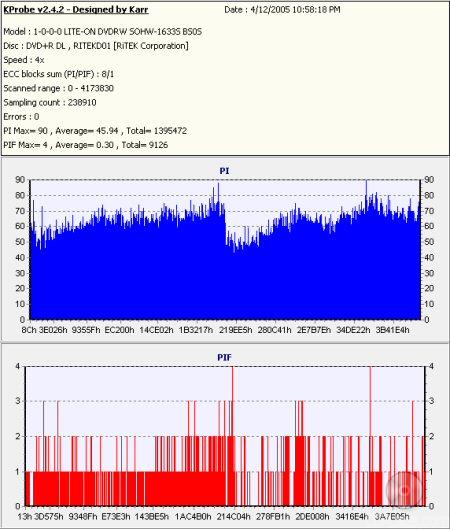

Model: BenQ DW1625 LightScribe 16x DVD±RW
Manufacturer: BenQ
Provided By: BenQ
When it comes to labeling your CD's and DVD's, there are few affordable options. The most popular way is to use a permanent marker. While quick and easy, the results are often messy and not very professional looking. Using stick on labels look much better, but they too have their downsides. They have a tendency to smudge when wet, curl with age and if not centered, can cause discs to become unbalanced. Using inkjet printable discs does eliminate most of these problems. However, buying a compatible printer can be a costly investment, especially for consumers.

While it took longer than many expected, LightScribe products have finally started to ship. One of the first DVD writers to take advantage of this new technology is the DW1625 from BenQ. Announced this January, the DW1625 offers 16x DVD+R, 8x DVD-R, 4x DVD±RW and 2.4x DVD+R DL writing speeds and a maximum DVD read speed of 16x. The drive also includes features like 40x CD reading and writing speeds, 24x rewriting speeds, and support for BenQ's own Write Right technology.
With LightScribe being the hot, new technology, we couldn't wait to get the DW1625 in the 'Labs. For the past few weeks, we polished our label creating skills, giving BenQ's new drive a thorough workout.Does LightScribe live up to the hype? Is the DW1625 the drive for you? Keep reading as we find out.
For this article, BenQ sent us the DW1625, a few pieces of blank LightScribe media and a CD containing software from Nero. The only things missing from the retail package are the installation guides, mounting screws and of course, the box.
Physical Features:
The drive BenQ sent us for this review was manufactured in February of 2005 and had firmware BBAA.For this review the drive's firmware has been updated to version BBEA.
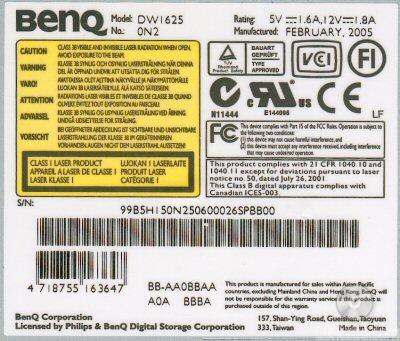
From the front, the DW1625 looks very similar to BenQ's previous 16x DVD±RW, the DW1620. Both drives share the same basic design and have many of the same logos. Along with the "BenQ" logo, you can see a few showing support for DVD+R DL, DVD-R/RW and Ultra Speed CD-RW media. The only real difference between the two drives is the large "LightScribe" logo on the DW1625's tray.
The DW1625 also has a single LED, which does double duty for both reading and writing activities.It lights up green when reading and red when writing or erasing. To the left of the LED is the drive's eject button. While slimmer than the eject buttons found on some of BenQ's earlier DVD writers, it does the trick.
The rear of the DW1625 looks very similar to some of the other BenQ based drives we've reviewed. Looking at the picture below, you can see the drive's IDE interface, power connector and audio output connectors.
Starting from the left of the IDE connection you'll see the jumper switch for master, slave and cable select. Next to the jumper block is the analog audio connector. The connector on the far left is the digital audio output.
Technical Specs:
The specs below have been taken from BenQ's website and by running a few simple tests.
| BenQ DW1625 16x DVD±RW | |
| CD Write Speeds | 40x (CAV) 32x, 24x (P-CAV) 16x, 12x, 8x (CLV) |
| CD Rewrite Speeds | 24x (P-CAV) 16x, 10x, 4x (CLV) |
| DVD+R Write Speeds | 16x (CAV) 8x (P-CAV) 4x, 2.4x (CLV) |
| DVD+RW Write Speeds | 4x, 2.4x (CLV) |
| DVD-R Write Speeds | 8x, (P-CAV) 4x, 2.4x (CLV) |
| DVD-RW Write Speeds | 4x, 2x, 1x (CLV) |
| DVD+R DL Write Speeds | 2.4x (CLV) |
| DVD Read Speeds | 16x Max (DVD-ROM Single Layer) 8x Max (DVD-ROM Dual Layer) 8x Max (DVD-R/RW) 8x Max (DVD+R/RW) 8x Max (DVD+R DL) |
| CD-ROM Read Speed | 40x Max |
| DAE Speed | 40x Max |
| Buffer Size | 2 MB |
| Random Access Times |
120 ms (CD) 160 ms (DVD) |
| CD Formats | CD-DA CD-ROM CD-ROM XA CD-R CD-RW Bootable CD Video CD Super Video CD Photo CD CD-Text CD Extra Mixed Mode |
| DVD Formats | DVD-ROM DVD-Video DVD+R/RW DVD-R/RW DVD+R DL |
| CD Recording Modes | Track At Once Session At Once Disc At Once Fixed and Variable Packet Writing Direct Over Write (CD-RW) Multisession Test Write |
LightScribe:
The DW1625 is the one of the first drives to feature LightScribe technology. Developed by HP, LightScribe lets you burn durable, silk screen quality labels directly onto your CD's and DVD's using the same drive that burned the data. According to HP, it's as simple as burning the data, flipping the disc, and then burning the label.
Of course you can't do this with just any drive, media or software. While LightScribe capable drives use the same laser when burning both the data and label, they have to be able to accurately control the laser's focus and position as well as the spindle speed. They also must be able to recognize LightScribe media. These special discs have a thin dye coating on the label side that absorbs laser light. This triggers a chemical reaction that produces a color change, allowing the user to print text, artwork or graphics.
Even if you have a LightScribe capable drive and media, you will need software that supports it. Most major software companies have pledged support for the technology. However, at the time of this review, the list of compatible software is still relatively short. For the DW1625, BenQ turned to Nero. Using the bundled software you can both create and burn LightScribe disc labels.
To create a LightScribe label, you can use either Nero Cover Designer or Nero Express. While both programs will let you add your own text and graphics, you cannot print LightScribe labels directly from Nero Cover Designer. To do this, you'll need to use Nero Express. As you can see, there is an extra option at the bottom used to print a LightScribe label. Selecting this option brings up the screen you see below.
Once you've completed your LightScribe label, you're ready to print it. Before you can do this though, you will need to choose the contrast. Keep in mind, this option not only changes the level of detail, it also affects the amount of time it takes to print the label. The higher the quality, the longer the process will take.
How long does it take to print a label? For testing purposes, we printed one disc at each contrast level using Verbatim's new LightScribe CD-R media. The results are shown below.
As you can see, LightScribe labels look much better when the contrast is set to "Normal" or "Best". The printing is much darker and more defined. The negative side effect to this is that it does increase the time considerably. Of course, this time will vary depending on the amount of text or graphics.
While you can't erase what you've written, LightScribe will allow you go to back and add additional text and graphics. You can even improve the quality if you want. To test this capability, I used one of Verbatim's new LightScribe DVD+R discs. As you can see, the surface of these discs is a little darker than that of their CD-R media.
To get the new content to line up with the existing text and images, the drive needs to start writing from the same spot. To do this, it first reads the special LightScribe information encoded in the ring around hub of the disc. Using this information, it then adjusts the disc and laser to find this starting position. Needless to say, you wouldn't be able to do this with a traditional label printer.
While permanent for the most part, LightScribe labels aren't immune to the elements. According to HP, exposure to ultraviolet light will cause them to fade in time. You also have to be somewhat careful when handling the discs as chemicals on your fingers as well as those in some hand lotions can cause discoloration. Of course, if the data on the disc was truly important, you'd keep it out of the sun and handle it with care anyway.
Write Right Technologies:
The DW1625 features what BenQ calls their "Write Right Technologies." Consisting of WOPC II, Tilt Control and Sliding Cone Mechanism, these technologies work together to deliver the best writing quality possible.
WOPC II (Walking Optimal Power Control) - In the past, drives would use a preset writing strategy and stick to it throughout the entire burning process. That's not the case with BenQ's WOPC II technology. It constantly monitors and evaluates writing quality, adjusting the writing power in order to ensure the best writing quality possible over the entire disc.
The screen shot below shows WOPC II in action. The dips in the graph indicate where WOPC II has adjusted the writing power of the laser.
With the DW1625, BenQ has also implemented BLER OPC (Block Error Rate Optimal Power Control). Similar in function to WOPC II, this technology enhances the writing quality near the end of the disc to prevent any warping or other potential problems.
WOPC II does have one negative side effect. Its constant monitoring can extend the burning time. BenQ has responded to this issue, giving users the ability to disable WOPC using their QSuite utility.
Tilt Control - The best reading and writing quality occurs when the angle between the disc and laser is 90 degrees. If a disc is warped the laser beam will not be positioned correctly. To remedy this, BenQ developed Tilt Control technology. With this technology, the DW1600 can reposition the OPU (Optical Pickup Unit) to maintain a 90 degree angle between the disc and laser.
Sliding Cone Mechanism - In an attempt to improve the position of the disc on the DW1600's turntable, BenQ has implemented their Sliding Cone Mechanism.
According to BenQ, this new mechanism provides better clamping force over the disc for auto centering. The result is faster access times, improved reading and writing quality and reduced noise and vibration levels.
More Features:
By looking at the picture below, you can see that BenQ's new DVD writer is identified as a "BENQ DVD DD DW 1625."
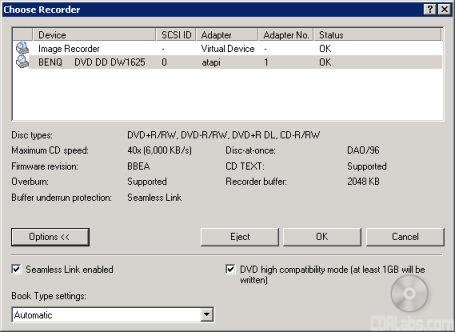
Nero also shows that the DW1625 has a maximum CD writing speed of 40x and a 2048KB buffer. This buffer is backed up by Seamless Link buffer underrun protection. According to Nero, the DW1625 can write CD-Text and overburn. When testing the drive's capacity, it had no problems overburning up to 99 minutes with our CompUSA media.
Like BenQ's previous DVD writers, the DW1625 can do EFM encoding correctly. Using CloneCD version 4.2.0.2 with AWS disabled, Iwas able to reproduce older SafeDisc 2 protected titles like Max Payne along with some of the newer ones protected by SafeDisc 2.51 like Serious Sam: The Second Encounter.
Here is a screen shot from Nero's InfoTool. This program queries the drive to see what its reading and writing capabilities are. InfoTool had no problems detecting the DW1625's maximum reading and writing speeds, recording modes, buffer underrun protection and 2MB buffer. Take note that the drive does not support the DVD-R DL format.
InfoTool also shows that the DW1625 is an RPC-2 DVD drive. This means that the drive's region is stored in the firmware. The drive's region can be changed five times and after that it cannot be changed anymore. Unfortunately, a patched RPC-1 firmware is not yet available for this drive.
While InfoTool gives us a quick glance at the DW1625's features, DVDINFOpro provides a little more information on some of the drive's reading and writing capabilities. By looking at the screenshot above you can see that while BenQ's new drive can read and write to DVD+R DL media, it does not support the Mt. Rainier format for CD-RW or DVD+RW.
The DW1625 also supports a feature called "bitsetting." Using BenQ's QSuite utility you can set the book type for DVD+R, DVD+RW and DVD+R DL media. By doing so, your recorded discs will identify themselves as "DVD-ROM." This feature comes in handy if you have an older DVD player that has problems playing recordable media.
BenQ also includes a CD full of software with the DW1625. Along with BenQ's own QVideo and QScan utilities, this disc contains a number of applications from Nero including Nero Express 6, NeroVision Express 3, Nero Recode 2, Nero BackItUp, Nero ShowTime 2 and InCD.
Nero Express 6 - With Nero Express, Nero has taken the features and performance people have come to expect from Nero Burning Rom and combined them with a user friendly interface. While the interface has been simplified, Nero Express still supports more advanced features like VCD and DVD creation, CD/DVD duplication, overburning, CD-Text and realtime audio filters
The version of Nero Express that BenQ included with their new DVD±RW drive is 6.6.0.6. You can download the latest version of the software from Nero's website.
NeroVision Express 3 - NeroVision Express 3 is the latest version of Nero's video authoring application. Using a user friendly interface very similar to that of Nero Express, NeroVision Express makes it easy for users to capture, edit and then burn their favorite videos to VCD, SVCD or DVD or export it to Nero Digital format.
NeroVision Express also lets users add things like transitions, custom backgrounds, animated menus and text effects. You can even use it to turn your photos into custom slide shows.
Nero Recode 2 - This new program from Nero can copy unprotected DVD videos onto recordable DVD media. If the source disc is larger than 4.7GB, Nero Recode 2 has the ability to remove unwanted material and compress the contents so that it will fit onto a single blank DVD disc.
Nero Recode 2 will also let you convert your DVD movies to Nero Digital. Using Nero's own MPEG-4 audio and video encoder, an entire DVD movie can be compressed so that it will fit onto a CD. Better yet, Nero Recode 2 does this without any loss of quality.
Nero BackItUp - If you're looking for a way to quickly and easily backup your data, Nero BackItUp is the answer. This new program from Ahead Software lets you backup your data to CD/DVD, hard disc, image recorderor another computer on your LAN.
Nero ShowTime 2 - Nero ShowTime is Nero's software DVD player. Along with support for DVD's, ShowTime can be used to play back VCD's, SVCD's and miniDVD's as well as any MPEG or AVI files you might have on your hard drive.
InCD 4 - InCD is Nero's packet writing software. Like Roxio's Drag-to-Disc or Sonic's DLA, it allows a person to use their CD-RW drive as a big floppy disk. The person can then drag and drop files onto a CD-RW or DVD±RW disc. Many people consider InCD to be one of the best packet writing tools because of its simplicity and performance.
BenQ QVideo 2.0 - With QVideo, BenQ has made the process of transferring video to DVD as painless as possible. This small, easy to use program takes the video feed from a variety of TV, DV and AV sources and will burn it directly to disc in real time. No capturing, rendering or authoring of the video footage is needed.
BenQ QSuite 1.0 - The DW1625 also comes with BenQ's new QSuite utility. This group of tools displays information about the drive and lets you adjust many of its functions. Along with the ability to set the booktype, you can enable/disable features like WOPC and Test Write. While not normally part of the DVD+R/RW spec, Test Write will let you run burn simulations on this type of media.
Using the QScan tool, you can also test blank DVD media for Tracking and Focus Errors, or TE/FE. By measuring a disc's TE/FE signal, QScan is able to determine its quality and whether or not it will successfully burn at the desired speed. For the best results, the lines on the graph should remain low and relatively flat.
The DW1625 also has the ability to measure a disc's PIE/PIF/POF and Jitter rates. Unfortunately, these tests are not supported by QScan. However, they are fully supported by programs like CD Speed and DVDINFOpro.
With the DW1625, BenQ has delivered one of their most feature packed drives to date. Their new DVD±RW supports most CD and DVD formats and has specs like 16x DVD+R, 8x DVD-R, 4x DVD±RW and 2.4x DVD+R DL writing speeds and a maximum DVD read speed of 16x. While the DW1625's most notable feature is its LightScribe disc labeling system, it also supports many of the ones we've come to expect from BenQ including Write Right, QScan and bitsetting. Last but not least, BenQ tops all of this off with an impressive software bundle from Nero. With all this it's easy to see why the DW1625 gets the full 10 points for its features.
Installing an optical drive in your computer is probably one of the easiest upgrades you can do. From start to finish, it took only a few minutes to install the DW1625 in our test computer. After taking the drive out of the box, I left the jumper set to master and installed it on the secondary IDE chain by connecting the IDE cable and power connector. When I turned on the computer the BIOS detected it as supporting UDMA 33. After making sure that the DMA was enabled in the Device Manager, I was ready to start installing the software.
Software Installation:
As I mentioned earlier, the DW1625 comes with a CD full of software containing a number of different applications from Nero and BenQ. If you have autorun enabled on your computer, the menu pictured below should automatically appear when you insert the disc.
At this point, you can choose to install the Nero Suite, BenQ QVideo, BenQ QSuite or the Adobe Acrobat Reader. Clicking on the little arrow/computer icon to the right of each will bring up their respective setup program. Otherwise, you can check out the documentation by clicking on the little book shaped icons.
Clicking on "Nero Suite" will bring up the menu pictured above. From here you can install Nero Express,NeroVision Express, InCD 4, or the InCD Reader. You can install each component individually, or everything but InCD in one shot. Once you reboot, you'll be ready to start burning your own discs.
Installing the BenQ software is fairly straightforward as well. In both cases, it's as simple as choosing the location where you want to install the program, clicking next a few times and waiting for the setup program to copy the files over. Once it's done, you'll be able to start transferring video directly to DVD and control many of the DW1625's functions.
Documentation:
While the retail version of the DW1625 comes with a fair amount of documentation, the majority of it focuses on the bundled software and not the drive itself. The closest thing to a manual is the drive's Quick Installation Guide. Similar to the ones included with BenQ's previous DVD writers, this small, fold out guide is broken up into 11 different languages. As you can imagine, with this many languages crammed into a guide of this size, it's hard to include a lot of information. Nevertheless, the diagrams BenQ has provided do take the user step by step through the installation process. If you're looking for things like the DW1625's specs or system requirements, you'll have to check the back of the box. You won't find that information in the guide.
Like the other BenQ drives we've looked at, the DW1625 was very easy to install. Even though LightScribe is a new technology, there were no problems getting the drive or the software installed and working correctly. BenQ also went the extra mile, including a good amount of software documentation. However, I personally would have liked to have seen a little more information on the drive. With this in mind, I give the installation an 8 out of a possible 10.
While CPU, memory, OS and other variables don't often make a huge difference, there are some nonetheless. We have a computer that is used only for testing hardware. We do this so all tests can be compared reliably.
Test System:
| CPU: | AMD Athlon 64 3200+ 2.0GHz | |
| Motherboard: | ASUS K8V SE Deluxe with BIOS 1003 | |
| Memory: | 2 x 256MB Kingston PC3200 | |
| Video Card: | XFX NVIDIA GeForce FX5200 - ForceWare v56.72 | |
| Hard Drive: | Hitachi Deskstar 7K80 80GB SATA 7200RPM | |
| Operating System: | Windows XP SP1 - VIA Hyperion 4in1 v4.51 |
For DVD writers the performance tests are broken down into four sections: CD read, CD write, DVD read and DVD write tests. Each benchmark test has been run three times. The score given is an average of the three. DMA has been enabled in device manager for all IDE devices supporting it.
CD Read Tests: For the read performance section of the CD-ROM benchmarks, CD WinBench 99 v3.0 and CD Speed v3.70 are used to test read speeds, seek times and CPU usage. For DAE testing both CD Speed and CD DAE are used. CD Speed is used to give an overall DAE speed rating and CD DAE is used to give the track by track extraction speeds and to check the extracted tracks for errors the drive may have created.
CD Write Tests: To test the write speeds, Nero Burning Rom is used to write 650MB and 700MB to our test media. Times are recorded. To test rewrite scores, Nero is used again to time how long it takes to write 400MB of random files and directories. Then Sonic's DLA is used to test packet writing speeds. The same files are copied and pasted in Windows Explorer and timed.
DVD Read Tests: For the read performance section of the DVD benchmarks CD Speed v3.70 is used to test read speeds, seek times, and CPU usage.
DVD Write Tests: To test the DVD write speeds, Nero Burning Rom is used to write 4GB to our test media. Times are recorded. Then Sonic's DLA is used to test packet writing speeds. The same files are copied and pasted in Windows Explorer and timed.
CD Winbench 99 Scores:
| BenQ DW1625 |
Pioneer DVR-A09XL |
NEC ND-3520A |
Plextor PX-716A |
|
| CD Winbench 99 | 1438 KB/sec | 1155 KB/sec | 1848 KB/sec | 2065 KB/sec |
| Transfer Rate: Inside | 2528 KB/sec | 2150 KB/sec | 3210 KB/sec | 3140 KB/sec |
| Transfer Rate: Outside | 5500 KB/sec | 5720 KB/sec | 6360 KB/sec | 6360 KB/sec |
| Random Access Time | 112ms | 112ms | 106ms | 96ms |
| CPU Utilization | 0.26% | 0.25% | 0.27% | 0.31% |
The CD Winbench test is as close as we can get to testing every day usage. It fires off eight different applications using scripts. This tries to mimic the activities of a person loading these programs onto their own computer.
BenQ's new DVD writer gave us some mixed performance in our CD Winbench tests. While the DW1625 started out fairly quick, its outside transfer rate and overall score were not as high as some of the other drives.
CD Speed v3.70 - Pressed CD:
For this test I used a pressed CD containing one Mode 1 data track. The disc is 74:38 in size and is full of data and directories.
| BenQ DW1625 |
Pioneer DVR-A09XL |
NEC ND-3520A |
Plextor PX-716A |
|
| Transfer Speed Average: Start: End: |
30.65x 17.48x 40.55x |
31.29x 18.14x 41.16x |
35.48x 20.42x 46.89x |
35.46x 20.50x 46.90x |
| Seek Times Random: 1/3: Full: |
106ms 118ms 172ms |
102ms 115ms 189ms |
120ms 133ms 223ms |
102ms 120ms 172ms |
| CPU Usage 1x: 2x: 4x: 8x: |
1% 2% 3% 7% |
8% 8% 13% n/a |
1% 1% 3% 6% |
0% 1% 2% 3% |
BenQ's new DVD writer performed fairly well here. While not as fast as the other drives when reading pressed CD's, it had no problems reaching its rated speed in our tests. Looking at the other scores, you can see that the DW1625's seek times were also pretty good.
CD Speed v3.70 - CD-R Media:
For this test I made a copy of our pressed test CD. I used 12x rated Memorex Gold 74 minute media for the tests.
| BenQ DW1625 |
Pioneer DVR-A09XL |
NEC ND-3520A |
Plextor PX-716A |
|
| Transfer Speed Average: Start: End: |
31.32x 17.72x 41.54x |
31.67x 18.18x 42.13x |
36.21x 20.63x 47.99x |
36.24x 20.73x 48.03x |
| Seek Times Random: 1/3: Full: |
103ms 112ms 171ms |
109ms 123ms 202ms |
121ms 132ms 222ms |
105ms 130ms 191ms |
| CPU Usage 1x: 2x: 4x: 8x: |
1% 2% 4% 7% |
0% 6% 2% n/a |
1% 1% 3% 6% |
0% 1% 2% 4% |
Like the other drives, the DW1625 was a little faster when reading CD-R media. Thanks to this slight speed boost, it was able to reach a maximum transfer speed of 41.54x. Looking at the other scores, you can see that the drive's seek times were again quite good.
The DW1625 had no problems recognizing our 99 minute CompUSA media. The drive read our test disc from start to finish, reaching a maximum transfer speed of 44.67x!
CD Speed v3.70 - CD-RW Media:
For this test I made a copy of a pressed test CD. I used some PNY 80 minute CD-RW media for the tests.
| BenQ DW1625 |
Pioneer DVR-A09XL |
NEC ND-3520A |
Plextor PX-716A |
|
| Transfer Speed Average: Start: End: |
30.77x 17.64x 40.68x |
24.95x 14.55x 32.95x |
25.59x 14.86x 33.80x |
31.53x 18.32x 41.64x |
| Seek Times Random: 1/3: Full: |
103ms 114ms 168ms |
104ms 121ms 195ms |
124ms 133ms 223ms |
101ms 118ms 174ms |
| CPU Usage 1x: 2x: 4x: 8x: |
1% 2% 4% 7% |
0% 1% 3% n/a |
1% 1% 3% 6% |
0% 1% 2% 4% |
The DW1625 didn't slow down very much when reading CD-RW media. As you can see, the drive had no problems reaching a maximum transfer speed of 40x in our tests.
CD DAE and CD Speed v3.70 - Pressed CD:
For this test I used Pure Funk. The CD is almost exactly 74 minutes. This helps to squeeze the maximum performance out of the CD.

Exact Audio Copy can tell us a lot about a drive's capabilities. You can see from the screen shot that while BenQ's new DVD writer supports accurate stream, it does not have the ability to cache audio data nor can it retrieve C2 error information.
| CD Speed | BenQ DW1625 |
Pioneer DVR-A09XL |
NEC ND-3520A |
Plextor PX-716A |
| Average: Start: End: DAE Quality: Accurate Stream: |
30.95x 17.71x 40.90x 10 Yes |
30.11x 17.96x 30.84x 10 Yes |
25.75x 14.93x 34.01x 10 Yes |
31.45x 18.20x 41.55x 10 Yes |
The DW1625 did relatively well in our DAE tests. While not as fast as the drive from Plextor, it had no problems reaching a maximum DAE speed of 40.90x.
To get a better look at the quality of the extracted audio we use CD DAE. CD DAE is actually designed to be an audio ripping program. It converts the CD-DA on the CD to .wav files. We use it in our testing because it can also be used as a quick and easy way to test the quality. Where CD Speed tests the DAE as one large session, CD DAE extracts each CD track individually. It actually extracts each track twice and then compares them to check for any errors. Every error a drive creates could be a hiss or pop you would hear later in the audio tracks.
| CD DAE | BenQ DW1625 |
Pioneer DVR-A09XL |
NEC ND-3520A |
Plextor PX-716A |
| Average: Min: Max: |
28.9x 18.6x 39.9x |
24.7x 18.8x 33.1x |
24.4x 15.5x 33.4x |
29.6x 18.6x 40.2x |
| Errors | 0 | 0 | 0 | 0 |
While BenQ's new writer started out a little faster when extracting our test CD with CD DAE, its average and maximum speeds were a little slower than what we saw with CD Speed.
CD DAE and CD Speed v3.70 - CD-R Media:
For this test I used a copy of the Pure Funk CD. It's burned onto the same Memorex Gold 74 minute media I used in the CD Speed tests.
| CD Speed | BenQ DW1625 |
Pioneer DVR-A09XL |
NEC ND-3520A |
Plextor PX-716A |
| Average: Start: End: DAE Quality: Accurate Stream: |
30.67x 17.73x 40.44x 10 Yes |
30.51x 18.09x 41.10x 10 Yes |
25.51x 14.91x 33.63x 10 Yes |
31.50x 18.32x 41.64x 10 Yes |
The DW1625 was a little slower when extracting audio from CD-R media. Nevertheless, it had no problems reaching a maximum DAE speed of 40x in our tests. So how did it do in CD Speed's advanced DAE tests? Take a look below.

BenQ's new DVD writer completed CD Speed's advanced DAE tests with an average score of 29.16x. The drive had no problems passing all of the on-the-fly tests and did not create any errors. In the advanced tests, the DW1625 was able to read the CD-Text, subchannel data and lead in but was not able to read the lead out section of the CD.
| CD DAE | BenQ DW1625 |
Pioneer DVR-A09XL |
NEC ND-3520A |
Plextor PX-716A |
| Average: Min: Max: |
28.8x 18.6x 39.4x |
28.6x 18.8x 39.9x |
24.2x 15.5x 33.0x |
29.9x 19.1x 40.8x |
| Errors | 0 | 0 | 0 | 0 |
To see how well BenQ's new drive can read scratched and dirty discs, I used CD Speed's ScanDisc utility to see how many sectors were damaged or unreadable. This is a very rough, but good way to test the drive's error correcting abilities.

CD Speed - ScanDisc
While all of that green looks good, these ScanDisc results are a little misleading. Without the ability to retrieve error information, the DW1625 is unable to determine which sectors are damaged or unreadable.
You can also get an idea of how well the drive can read scratched and dirty discs by using CD DAE. CD DAE will extract the audio tracks twice and then compare them. From this information we can see what the drive's average speed was and how many errors it generated.
| CD DAE | Avg. Speed | Errors | % of Disc |
|
BenQ DW1625 |
5.9x | 41275853 | 5.27% |
|
Pioneer DVR-A09XL |
1.8x | 74809384 | 9.55% |
|
NEC ND-3520A |
8.2x | 103625381 | 13.23% |
|
Plextor PX-716A |
23.2x | 57330566 | 7.31% |
The BenQ gave some mixed results in this test. While it had the lowest number of errors, the scratches on the disc caused it to slow down considerably.
CD Write and ReWrite Tests - Nero Burning Rom 6.6.0.8 and DLA 4.90:
For this test I randomly generated 650MB and 700MB of files and directories to test the time it takes the drive to write and close a CD. All of the files are between 1MB and 25MB in size and no more than 10 directories deep. All of the times below include not only the actual writing time, but the lead in and out times too. This gives a more realistic idea of how long it takes to write a CD.
Like the DVR-A09XL, the DW1625 has a maximum CD writing speed of 40x. To reach this speed, it uses CAV, or Constant Angular Velocity. With Imation's 48x media, it started writing at about 17.73x and reached a maximum speed of 39.79x at the end of the session. This gave BenQ's new drive an average writing speed of about 30.19x.
To test the DW1625's writing times, I wrote our test data to some Taiyo Yuden manufactured Fuji media rated at 48x. The results are below.
| Size in MB | Size in Time | BenQ DW1625 |
Pioneer DVR-A09XL |
NEC ND-3520A |
Plextor PX-716A |
| 651MB | 74:02:55 | 3:08 | 3:14 | 2:53 | 2:38 |
| 701MB | 79:44:21 | 3:16 | 3:30 | 3:04 | 2:44 |
BenQs new DVD writer did fairly well in our tests. While no match for the drives from NEC and Plextor, the DW1625 was able to write an entire 650MB CD in a little more than 3 minutes.
To test the drive's writing quality I used Lite-On IT's KProbe2. Written by Karr Wang, this utility can be used to test the number of C1 and C2 errors on a disc. For these tests I used a Lite-On LTR-52246S (firmware 6S0F) and read the discs at 32x.
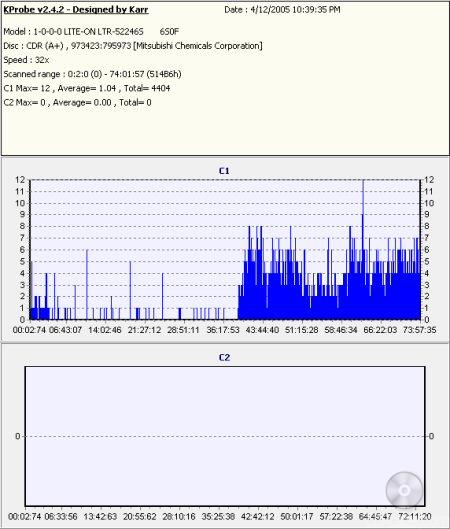 Verbatim 52x |
The DW1625's writing quality is very good. By looking at the KProbe screenshots, you can see that the discs burned by the drive had a low number of C1 errors and there were no C2 errors at all.
For the rewriting tests I created 400MB of files on the hard drive and wrote them in DAO mode using Nero. To test the packet writing speeds I copied and pasted the same files off the hard drive onto a CD-RW disc using DLA from Sonic. Verbatim's 24x Ultra Speed CD-RW media was used for these tests.
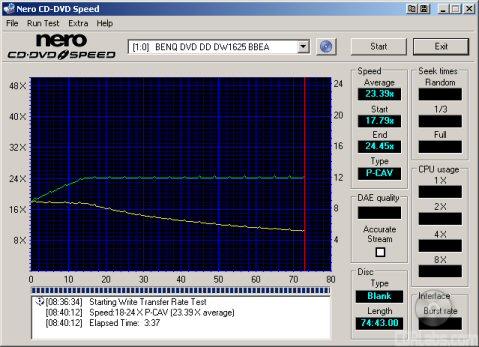
When rewriting at 24x, the DW1625 uses P-CAV, or Partial CAV, to reach this speed.By looking at the screenshot above, you can see that the drive starts rewriting at about 17.79x and accelerates, reaching its maximum speed at about the 14 minute mark.
| Software | BenQ DW1625 |
Pioneer DVR-A09XL |
NEC ND-3520A |
Plextor PX-716A |
| Nero | 2:23 | 2:58 | 2:42 | 2:21 |
| DLA Write | 2:29 | 2:38 | 2:24 | 2:25 |
| DLA Read | 1:14 | 4:05 | 1:34 | 2:24 |
BenQ's new DVD writer did very well in our rewriting tests. Thanks to its P-CAV writing method, the DW1625 took only 2:23 to write 400MB with Nero and 2:29 to do the same with DLA.
| BenQ DW1625 |
Pioneer DVR-A09XL |
NEC ND-3520A |
Plextor PX-716A |
|
| Quick Erase | 32 seconds | 41 seconds | 42 seconds | 42 seconds |
| Full Erase | 3:49 | 4:12 | 4:10 | 3:52 |
The DW1625 also erases at 24x. In our tests, it not only had the best quick erase time out of the four drives here, it was able to do a full erase in an impressive 3:49.
Nero CD Speed v3.70 - DVD-ROM:
A little editorial note here. Like a CD-ROM, you will get different benchmark results depending on what kind of discs you are using. You are probably going to get varying results from a full data disc to a single layer movie disc. You're also going to get different results for single and dual layer discs.
The DVD Speed website recommends using a single layer DVD-ROM disc with a capacity of at least 4GB. If you use a dual layer disc you probably won't get the best results because most DVD-ROM drives slow down to read them. Some even slow down to read single layer DVD-Video discs. To make a long story short, I am using a 4.37GB single layer, single sided disc for this test.
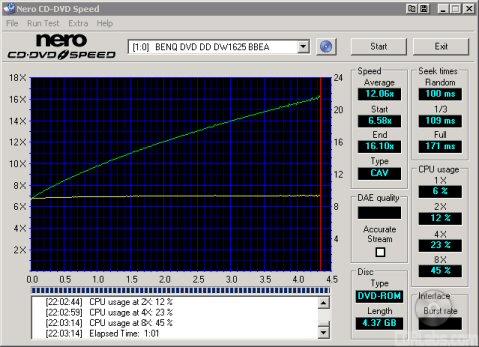
| BenQ DW1625 |
Pioneer DVR-A09XL |
NEC ND-3520A |
Plextor PX-716A |
|
| Transfer Speed Average: Start: End: |
12.06x 6.58x 16.10x |
11.99x 6.64x 16.06x |
11.89x 6.52x 15.89x |
12.07x 6.63x 16.14x |
| Seek Times Random: 1/3: Full: |
100ms 109ms 171ms |
110ms 129ms 209ms |
128ms 138ms 229ms |
101ms 111ms 187ms |
| CPU Usage 1x: 2x: 4x: 8x: |
6% 12% 23% 45% |
5% 9% 15% n/a |
8% 15% 28% 55% |
4% 8% 16% 31% |
BenQ's new drive performed very well when reading single layer DVD-ROM's. In the transfer rate tests, it started reading at 6.58x and reached a maximum transfer speed of about 16.10x. Like in our CD read tests, its seek times were also quite good.
Nero CD Speed v3.70 - DVD-R and DVD-RW:
First, we'll look at the drive's DVD-R and DVD-RW reading performance. For this I made copies of our DVD-ROM test disk using some general use 4x DVD-R and 2x DVD-RW media from Verbatim and then ran our usual DVD read tests with CD Speed. The results are below.
Verbatim DVD-R
| BenQ DW1625 |
Pioneer DVR-A09XL |
NEC ND-3520A |
Plextor PX-716A |
|
| Transfer Speed Average: Start: End: |
6.23x 3.43x 8.34x |
9.35x 5.19x 12.51x |
11.91x 6.56x 15.93x |
9.04x 4.99x 12.09x |
| Seek Times Random: 1/3: Full: |
104ms 115ms 172ms |
114ms 136ms 217ms |
122ms 146ms 251ms |
101ms 112ms 178ms |
| CPU Usage 1x: 2x: 4x: 8x: |
6% 12% 23% 45% |
6% 26% n/a n/a |
9% 17% 31% 63% |
4% 8% 15% 30% |
Verbatim DVD-RW
| BenQ DW1625 |
Pioneer DVR-A09XL |
NEC ND-3520A |
Plextor PX-716A |
|
| Transfer Speed Average: Start: End: |
6.24x 3.43x 8.33x |
6.25x 3.47x 8.36x |
5.97x 3.28x 7.98x |
9.06x 4.98x 12.12x |
| Seek Times Random: 1/3: Full: |
103ms 116ms 172ms |
121ms 138ms 238ms |
108ms 138ms 229ms |
101ms 114ms 197ms |
| CPU Usage 1x: 2x: 4x: 8x: |
6% 12% 23% 45% |
6% 26% n/a n/a |
8% 14% 26% 81% |
5% 8% 15% 30% |
BenQ's' new drive wasn't nearly as fast when reading DVD-R and DVD-RW media. In both cases, the DW1625 reached a maximum transfer speed of about 8.3x.
Nero CD Speed v3.70 - DVD+R and DVD+RW:
Next we'll look at the drive's DVD+R and DVD+RW reading performance. For this I made a copy of our DVD-ROM test disk using some 4x DVD+R and 2.4x DVD+RW media from Verbatim. I then ran our usual DVD read tests with CD Speed. The results are below.
Verbatim DVD+R
| BenQ DW1625 |
Pioneer DVR-A09XL |
NEC ND-3520A |
Plextor PX-716A |
|
| Transfer Speed Average: Start: End: |
6.21x 3.44x 8.30x |
9.36x 5.18x 12.53x |
11.93x 6.55x 15.95x |
9.04x 4.98x 12.09x |
| Seek Times Random: 1/3: Full: |
103ms 116ms 172ms |
116ms 140ms 221ms |
118ms 146ms 259ms |
101ms 110ms 194ms |
| CPU Usage 1x: 2x: 4x: 8x: |
6% 12% 23% 45% |
6% 27% n/a n/a |
9% 16% 31% 64% |
5% 8% 15% 30% |
Verbatim DVD+RW
| BenQ DW1625 |
Pioneer DVR-A09XL |
NEC ND-3520A |
Plextor PX-716A |
|
| Transfer Speed Average: Start: End: |
6.24x 3.43x 8.34x |
6.25x 3.46x 8.35x |
5.97x 3.29x 7.98x |
9.06x 4.99x 12.11x |
| Seek Times Random: 1/3: Full: |
102ms 118ms 172ms |
113ms 132ms 218ms |
111ms 141ms 235ms |
100ms 108ms 193ms |
| CPU Usage 1x: 2x: 4x: 8x: |
6% 12% 23% 45% |
7% 27% n/a n/a |
7% 13% 25% 81% |
5% 8% 16% 30% |
The DW1625's performance with DVD+R and DVD+RW media was very similar to what we saw with DVD-R and DVD-RW media. Here too the drive reached a maximum transfer speed of about 8.3x.
Verbatim DVD+R DL
| BenQ DW1625 |
Pioneer DVR-A09XL |
NEC ND-3520A |
Plextor PX-716A |
|
| Transfer Speed Average: Start: End: |
6.04x 3.35x 8.06x |
5.69x 3.17x 7.60x |
3.44x 1.91x 4.59x |
6.06x 3.35x 8.09x |
| Seek Times Random: 1/3: Full: |
107ms 119ms 172ms |
120ms 139ms 234ms |
123ms 175ms 279ms |
101ms 111ms 188ms |
| CPU Usage 1x: 2x: 4x: |
10% 20% 94% |
5% 10% n/a |
7% 91% n/a |
4% 7% n/a |
BenQ's new DVD writer had no problems reading Verbatim's double layer DVD+R media. The DW1625 started reading at 3.35x and reached a maximum transfer speed of 8.06x.
Nero CD Speed v3.70 - DVD-Video:
For these tests I am using the US version of Transformers: The Movie on DVD. The disc is over 4GB and single sided.
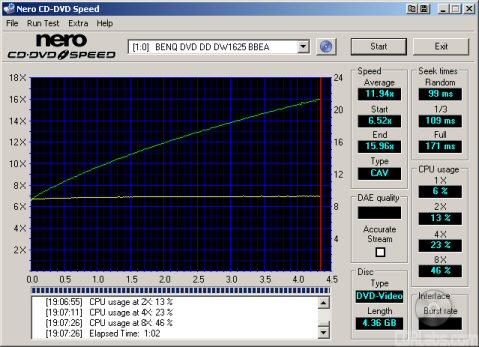
| BenQ DW1625 |
Pioneer DVR-A09XL |
NEC ND-3520A |
Plextor PX-716A |
|
| Transfer Speed Average: Start: End: |
11.94x 6.52x 15.96x |
11.87x 6.57x 15.95x |
3.72x 2.05x 4.98x |
12.07x 6.63x 16.14x |
| Seek Times Random: 1/3: Full: |
99ms 109ms 171ms |
110ms 126ms 206ms |
111ms 128ms 206ms |
103ms 111ms 179ms |
| CPU Usage 1x: 2x: 4x: 8x: |
6% 13% 23% 46% |
5% 9% 15% n/a |
7% 13% 23% n/a |
4% 8% 16% 31% |
The DW1625 didn't slow down very much when reading single layer DVD videos. It started out at about 6.52x and reached a maximum read speed of 15.96x. BenQ's new drive was also fairly quick when reading dual layer discs. By looking at the screenshot below, you can see that the drive's transfer speeds peaked at about 8x.
To see how well the DW1625 worked as a DVD player, I watched a few scenes from Transformers: The Movie and Star Wars: The Phantom Menace using WinDVD 4 and PowerDVD 5. The drive had no problems playing back these movies with either program and was fairly quiet.
DVD Write and ReWrite Tests - Nero Burning Rom 6.6.0.8 and DLA 4.90:
To test the DVD writing performance of BenQ's new drive I used Verbatim 16x DVD+R, 8x DVD-R, 4x DVD-RW and 4x DVD+RW media. To get the writing times, a 4.38GB image was burned to our test discs using Nero.
The DW1625 can write to DVD+R media at 16x. To reach this speed, the drive uses CAV. Using Verbatim's 16x DVD+R media, it starts writing at 5.56x and accelerates, reaching its maximum speed at the end of the disc. When writing to DVD+R and DVD-R media at 8x, BenQ's new drive uses P-CAV. This time around, the drive starts writing at about 6.70x and accelerates, reaching its maximum speed at about the 0.4GB mark.
The dips in the graphs are due to the DW1625's WOPC II (Walking Optimal Power Control) and BLER OPC (Block Error Rate Optimal Power Control) technologies and are not an indication of poor performance and/or writing quality. According to BenQ, these technologies constantly monitor and evaluate the writing quality, adjusting the laser power in order to ensure the best writing quality possible over the entire disc.
| BenQ DW1625 |
Pioneer DVR-A09XL |
NEC ND-3520A |
Plextor PX-716A |
|
| DVD+R | 6:06 | 5:50 | 6:05 | 5:59 |
| DVD-R | 8:14 | 6:08 | 5:42 | 6:01 |
| DVD+RW | 14:35 | 14:26 | 9:45 | 7:35 |
| DVD-RW | 15:46 | 10:23 | 10:47 | 14:46 |
While not the fastest drive we've tested, the DW1625 performed relatively well when writing to DVD+R discs at 16x. Unfortunately, due to its slower writing speeds, it had a hard time holding its own with other types of recordable media.
BenQ doesn't really say whether or not their new drive can write to 8x DVD+R media at 16x. To see if the DW1625 had this capability, I ran a few tests using some of the media available in my area.
| Manufacturer ID | Max Write Speed |
Average Write Time |
|
| Memorex 8x DVD+R | CMC MAG E01 | 8x | 8:34 |
| Taiyo Yuden 8x DVD+R | YUDEN000T02 | 8x | 8:34 |
| Memorex 16x DVD+R | CMC MAG M01 | 16x | 8:48 |
| Optodisc 16x DVD+R | OPTODISCR16 | 16x | 6:11 |
| RiDATA 16x DVD+R | RITEKR04 | 16x | 6:10 |
| Verbatim 16x DVD+R | MCC-004 | 16x | 6:06 |
| Maxell 8x DVD-R | MXL RG03 | 8x | 8:13 |
| Optodisc 8x DVD-R | OPTODISCR008 | 8x | 8:33 |
| RiDATA 8x DVD-R | RITEKG05 | 8x | 8:11 |
| Sony 8x DVD-R | SONY08D1 | 8x | 8:07 |
| Taiyo Yuden 8x DVD-R | TYG02 | 8x | 8:30 |
| Verbatim 8x DVD-R | MCC 02RG20 | 8x | 8:14 |
While the DW1625 wrote most of our test media at its rated speed, it was not able to write to any 8x DVD+R media at 16x. This was a little surprising considering BenQ's earlier drives had this capability.
So what about writing quality? Testing a drive's DVD writing quality isn't easy. Until now, there were very few options, unless you wanted to shell out thousands of dollars for a certified test machine. Thanks to KProbe, we can test a disc's PI (Parity Inner) and PIF (Parity Inner Fail) rates.For these tests I used a Lite-On SOHW-1633S (firmware BS0S) and read the discs at 4x with the PI and PIF ECC sums set to 8 and 1 respectively. For comparison, I also tested the discs on a BenQ DW1620. When combined with Nero CD Speed, the DW1620 is able to report PI Errors, PI Failures, Parity Outer Failures and even jitter levels. For this test, the discs are read at 8x with both the PI and PIF ECC sums set to 8.
So what are "good" results supposed to look like? With KProbe, the PI errors should not exceed 280 and the number of PIF errors should stay below 4. When testing with CD Speed, the number of PI errors should stay below 280 as well. However, because it scans with an ECC sum of 8, a higher number of PIF errors is acceptable, as long as they do not exceed 32. Since POF errors are uncorrectable, we really don't want to see any of them at all.
I also put these discs through a "stress test" by reading them back with a Lite-On XJ-HD166S. By default, this DVD-ROM drive reads recordable media at only 8x. However, thanks to a firmware patched by The Dangerous Brothers, I was able to boost the drive's read speed to 12x. By reading these discs back at this speed, we can see if there are any readability issues caused by the number of errors or high levels of jitter.
|
|
|
||||||||||||||||||||||||||||||||||||||||||||||||||||||||||||||||||||||||
|
|
|
||||||||||||||||||||||||||||||||||||||||||||||||||||||||||||||||||||||||
While not the best results we've seen, the DW1625's writing quality was fairly good with most of the DVD+R media we tested. The only exception being Optodisc's 16x DVD+R media. When scanned with the BenQ DW1620, the PI/PIF rates did get a little high. Oddly enough, these discs were some of the few that yielded a smooth transfer rate graph.
|
|
|
||||||||||||||||||||||||||||||||||||||||||||||||||||||||||||||||||||||||
|
|
|
||||||||||||||||||||||||||||||||||||||||||||||||||||||||||||||||||||||||
Lastly, here are some results from our DVD-R test media. The PI/PIF rates were pretty good for the most part. However, if you look at the transfer rate graphs you can see that there were still slow downs with a few of the discs.
| BenQ DW1625 |
Pioneer DVR-A09XL |
NEC ND-3520A |
Plextor PX-716A |
|
| DVD+RW Quick | 17 seconds | 27 seconds | 39 seconds | 32 seconds |
| DVD+RW Full | 14:51 | 14:23 | 7:49 | 7:46 |
| DVD-RW Quick | 51 seconds | 53 seconds | 55 seconds | 1:03 |
| DVD-RW Full | 15:51 | 10:21 | 14:43 | 15:09 |
To test the BenQ's packet writing performance I used DLA 4.90. Verbatim 4x DVD+RW and 4x DVD-RW media were used once again.
| BenQ DW1625 |
Pioneer DVR-A09XL |
NEC ND-3520A |
Plextor PX-716A |
|
| DVD+RW Write | 12:50 | 13:49 | 8:10 | 6:33 |
| DVD+RW Read | 8:58 | 14:47 | 9:20 | 5:47 |
| DVD-RW Write | 13:20 | 9:39 | 12:14 | 12:44 |
| DVD-RW Read | 9:02 | 11:40 | 9:46 | 6:05 |
The DW1625's packet writing performance was pretty mixed. While relatively quick when reading back our test data, the drive's 4x DVD±RW writing speed put it at a disadvantage once again.
DVD+R DL Write Tests - Nero Burning Rom 6.6.0.8:
To test the double layer DVD writing performance of the DW1625, I used DVD+R DL media from both RiDATA and Verbatim. I created about 8GB of random files and directories on my hard drive and then burned them to our test discs with Nero.
According to BenQ, the DW1625 writes to DVD+R DL media at 2.4x. Using CD Speed we can see that aside from the small dips caused by the drive's WOPC II and BLER OPC technologies, it writes at this speed from start to finish.
| DVD+R DL Write | BenQ DW1625 |
Pioneer DVR-A09XL |
NEC ND-3520A |
Plextor PX-716A |
| 2.4x | 45:12 | 44:17 | 42:53 | 43:42 |
| 4x | n/a | 27:04 | 26:17 | 26:47 |
| 6x | n/a | 19:04 | n/a | 18:17 |
The DW1625's 2.4x writing speed put it at a huge disadvantage in this test. As you can see, it was considerably slower than the other drives, taking more than 45 minutes to write 8001MB of data. So what about writing quality? Take a look below.
|
|
||||||||||||||||||||||||||||||||||||||||||||||||
The DW1625's writing quality was very good with the DVD+R DL media from Verbatim. Aside from the small spike at the layer change, the PI/PIF rates remained fairly low from start to finish. Unfortunately, the results weren't as good with RiDATA's DVD+R DL media. The PI/PIF rates were considerably higher, especially when tested using the DW1620 and CD Speed. Nevertheless, we didn't see any slow downs when reading the discs back with CD Speed.
Performance Revisited:
While the DW1625 performed as expected, it was not one of the faster 16x DVD writers we've tested. When it came to writing DVD's, the DW1625 turned in some pretty good times with DVD+R media. However, it's 8x DVD-R and 2.4x DVD+R DL writing speeds put it at a disadvantage in some of our tests. Nevertheless, the DW1625 was fairly quick when reading DVD's. In our tests, it was able to read single layer data and video DVD's at speeds as high as 16x and most recordable media at 8x.
The DW1625 also did pretty well in our CD read tests. The drive read all types of media at 40x and had some good seek times. Writing CD's wasn't a problem for the BenQ's new drive either. While not as fast as some of the other drives we've looked at, its writing quality was quite good. With all things considered, the BenQ DW1625 gets an 8 out of 10 for the performance section of this review.
BenQ has shown us again why they are considered to be one of the optical storage industry's leading innovators. With the DW1625, they've introduced one of the first LightScribe enabled DVD writers. Using the drive's laser, LightScribe lets users burn graphics and text onto the tops of specially coated discs. While this will appeal to many, I won't hesitate to point out the DW1625 isn't for everyone. As a first generation drive, it was designed primarily to showcase its LightScribe capabilities. In the process BenQ has had to make some sacrifices in regard to performance, a fact that probably won't go over well with enthusiasts.
Like the DW1620, the DW1625 is able to write to DVD+R media at 16x. At this speed, it took BenQ's new drive a little more than 6 minutes to write an entire 4.7GB DVD. While this is pretty impressive, the DW1625 wasn't as fast with other types of recordable media. As you saw in our tests, the drive's 8x DVD-R and 2.4x DVD+R DL writing speeds put it at a notable disadvantage. Just don't hold your breath waiting for an upgrade. According to our contacts at BenQ, they currently do not have any plans to increase the writing speed for either media type.
When it came to media compatibility, the DW1625 gave us some mixed results. While BenQ's new drive wrote to most of our test media at its rated speed, it would not write to any 8x DVD+R media at 16x. I have to admit that this was a little surprising considering BenQ's previous 16x DVD writers had this capability. The DW1625's writing quality was pretty good for the most part. However, there is still room for improvement, especially with Ritek's DVD+R DL discs. Knowing BenQ though, they're already tweaking the writing strategy in the next firmware.
The DW1625 performed pretty well in our DVD read tests. It read both single layer DVD-ROM's and DVD-Videos at speeds as high as 16x and had some very good seek times. Reading recordable media wasn't a problem for BenQ's new drive either. In our tests, the DW1625 read DVD-R/RW, DVD+R/RW and DVD+R DL media at a respectable 8x.
When it came time to read and write CD's, the DW1625 performed as expected. In our tests, the drive was able to read all types of media at 40x and had some good seek times. This level of performance carried over to our DAE tests, where the drive ripped audio CD's at 40x. As a writer, the DRW1625 performed reasonably well. While it had no problems holding its own in our rewriting tests, its 40x CD-R writing speed did put it at a slight disadvantage. Nevertheless, the drive's writing quality was very good.
Like BenQ's previous DVD writers, the DW1625 isn't short on features. Along with Seamless Link buffer underrun protection, the drive supports things like bitsetting and BenQ's Write Right Technology. While Write Right does help improve the writing quality, some of its features can increase the total burn time. Fortunately, you can disable it using the included QSuite utility. To top it all off, BenQ has included a great software bundle containing a number ofapplications from Nero.
Of course, the DW1625's biggest feature is its LightScribe Direct Disc Labeling system. While an alternative to markers and stick on labels, it's still too early to say whether or not this new technology will take off. Two things that might prevent LightScribe from doing so are the long printing times and the lack of color. Fortunately, media allowing faster printing speeds is already in the works and, according to BenQ, the DW1625 should support it. Color LightScribe media is also being developed and is expected to hit the market some time next year.
While affordable for a LightScribe capable drive, the DW1625 is still more expensive than most normal 16x DVD writers. The OEMversion of the drive can be picked up for as little as $90 on Pricewatch. Otherwise, if you'd rather go the retail route, prices start at about $120 and go up from there.
| BenQ DW1625 16x DVD±RW |
|
| Features: Installation: Performance: |
10 8 8 |
| Overall: | 8 |
Highs:
- Supports LightScribe technology
- Writes to DVD+R media at 16x
- Writes to DVD-RW and DVD+RW media at 4x
- Reads single layer DVD-ROM's at 16x
- Reads DVD+R/RW, DVD-R/RW and DVD+R DL mediaat 8x
- Good transfer speeds with all types of CD media
- Features 40x CD-R and 24x CD-RW writing speeds
- Good DAE speeds
- Low seek times
- Good CD writing quality
- Supports Seamless Link buffer underrun protection
- Includes software from Nero and BenQ
- Supports 99 minute media
- Supports bitsetting for DVD+R/RW and DVD+R DL media
- Supports FE/TE, PI/PIF/POF and Jitter testing
- Writes to DVD-R media at only 8x
- Writes to DVD+R DL media at only 2.4x
- Cannot write to 8x DVD+R media at 16x
- Questionable writing quality with Ritek DVD+R DL media
- Has a 2048KB buffer
- More expensive than normal 16x DVD writers
